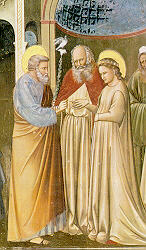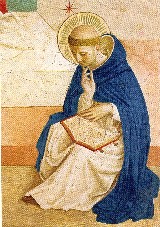

![]()
under the patronage of St Joseph and St Dominic
By the rivers of Babylon there
we sat and wept, remembering Zion;
on the poplars that grew there we hung up our harps. . . Ps 136

 |
under the patronage of St Joseph and St Dominic By the rivers of Babylon there
we sat and wept, remembering Zion; |

|
|
SAINTS
OF THE INTERREGNUM
“Think only this, that God ordains all...”
St John of the Cross[1]
How appropriate it is that in the week that has followed the death of Pope Francis and with the cardinals gathering to elect the new Pope, God’s Holy Church should aid them in their task by requiring them to celebrate the feasts of two saints who addressed errors similar to those that confront them today.
On April 30th occurred the feast of St Catherine of Siena who, in the 14th Century, laboured to direct - and correct - the popes of her era. On May 2nd there occurred the feast of St Athanasius who in the 4th Century stood almost alone against Arianism, the greatest heresy to afflict the Church until the worst of them, Modernism, raised its head late in the 19th Century.[2]
There are some remarkable parallels between the position in which the Church found herself in the fourth Century and that in which she finds herself today. In that century the majority of the Church’s bishops were infected with a heresy called Arianism (or semi Arianism). In the present century the majority of the bishops are infected with Modernism or semi-Modernism.
In 325 AD those attending the First Ecumenical Council of Nicaea defined certain fundamentals of the Catholic faith and in doing so condemned the priest, Arius, and his heresy. Ten years later in 335, however, at the First Synod of Tyre, the bishops assembled condemned Athanasius, Bishop of Alexandria, for his obduracy in refusing to readmit Arius to the Church. The effect of their action was to facilitate the spread of his heresy.
In the 19th Century, the Church’s bishops assembled to clarify and define fundamentals of the Catholic faith. This they did between 1869 and 1870 in Rome at the Vatican Council. Less than 100 years later the Church’s bishops, again assembled in a synod (led by successive Popes), sought to ‘update’ the Church - as if the Church Christ had established was not eo ipso timeless! The motivating force for this synod was the besottedness of a vocal minority of the bishops (aided and abetted by the two, Popes John XXIII and Paul VI) for the foolish philosophical ideas let loose by the Protestant Revolt, crystallised in the thinking of the so called ‘Enlightenment’.
Since the collection of ideas they endorsed grounded the Modernist heresy, the effect of this synod - asserted by the two Popes to be ‘an Ecumenical Council’ – facilitated its spread among bishops, clergy and faithful, serving to compel compliance with the Modernist agenda. Its errors were imported via a novel rite of Mass invented by Paul VI to replace the Church’s canonised millennial Roman rite. Since this false liturgy imposed on clergy and faithful alike a false understanding of the faith, it was schismatic. We have more to say on this below.
Each of the Popes who followed John XXIII and Paul VI was infected to a greater or lesser degree with the Modernist virus and blinded to the distortion of the Catholic Faith, and harm to the faithful, its tenets put in place. John Paul II and Benedict XVI were philosophically incompetent, John Paul because of his immersion in the errors of Phenomenology, Benedict because of his refusal to accept the Church’s own philosophy, the metaphysics of St Thomas Aquinas, preferring the flawed Modernist thinking underlying the nouvelle théologie. Benedict’s philosophical incompetence was to lead to his downfall. He erred over the grave matter of the terms of his ‘resignation’ from office in such fashion as to render it nugatory.[3] The result is that the probability is that Jorge Mario Bergoglio was never Pope.
A further saint of God’s Holy Church the cardinal electors were incited to keep in mind as they set about their task was St Pius V whose feast day occurred on Monday, May 5th. Pius V canonised the millennial Roman rite of Mass in the bull Quo primam (July 15th, 1570) complying, when he did so, with the explicit directions of the Council of Trent whose members, on March 3rd, 1547, had declared: If anyone shall say that the received and approved rites of the Catholic Church accustomed to be used in the solemn administration of the sacraments may be disdained or omitted by the minister without sin and at pleasure, or may be changed by any pastor whatsoever of the churches to other new ones, let him be anathema. (Session VII, Canon 13) It is notorious that in its ‘Constitution on the Sacred Liturgy’, Sacrosanctum Concilium, the bishops of Vatican II driven by the Modernist imperative, ignored this declaration and the terms of St Pius V’s bull, as did Paul VI when, in 1969, he imposed his novel rite of Mass on the Catholic faithful.
There was one final anniversary that bore upon the cardinals’ task: on the day following, May 6th, occurred the 50th anniversary of the death of József Cardinal Mindzenty, Archbishop of Esztergom and Primate of Hungary, whom Paul VI had abandoned so callously in 1971 as he indulged the then Vatican policy of ostpolitik.
**************************
We have the greatest respect for the views of Archbishop Carlo Maria Viganò but there are some theological issues that he misunderstands. His reliance on the purported disqualification of Pope Paul IV in 1559 in his Apostolic Constitution Cum ex apostolatus officio from holding papal office of any person who had been a heretic is plainly wrong. It has been systematically ignored by subsequent popes and its tenets were contradicted explicitly by Pope Leo XIII when, in 1879, he appointed former Protestant heretic, John Henry Newman, cardinal of the Church and therefore papabile.
Moreover, Archbishop Viganò’s opinion, more recently expressed, that Pope Francis’s action in appointing cardinals was ineffectual because he was never validly elected as pope ignores the reality that Christ’s Church is God’s creature, not a human invention, and that while men may err in their actions on behalf of the Church, God ensures the Church supplies for their defects. This reality is expressed in Canon 144 § 1 of the 1983 Code of Canon Law which has its provenance in the Church’s long legal history and repeats the burden of Canon 209 in the 1917 Code. Canon 144 is in these terms: In common error, whether of fact or of law, and in positive or probable doubt, whether of law or of fact, the Church supplies executive power of governance for both the external and the internal forum. Regardless of the view as to the legitimacy of his election at which the Church may someday arrive, Francis was Pope according to the Church’s law. That legal authority is sufficient to attract the force of Canon 144 § 1 so as to justify the legality of his appointments to the College of Cardinals. There is a real risk that the views of Archbishop Viganò might lead to schism if a body of the faithful should reject the man elected Pope by the cardinals on May 8th last, Leo XIV.
Let us pray daily that the new Pope may be zealous for the faith and pleasing to Almighty God and, by his good government of Christ’s Church, that he may be honoured by the faithful to the Glory of God and of His Holy Name.
Michael Baker May 2nd, 2025—St Athanasius Revised May 11th, 2025—Third Sunday after Easter [1] In his Letter to the Prioress of the Discalced Carmelites in Segovia, July 6th, 1591. [2] In Pascendi Dominic Gregis (September 8th, 1907) St Pius X labelled Modernism the synthesis of all heresies. [3] On this topic see the author’s ebook The Two Churches or the short paper with the same title available on superflumina.org |